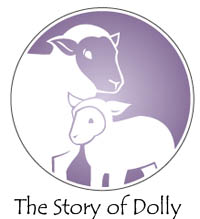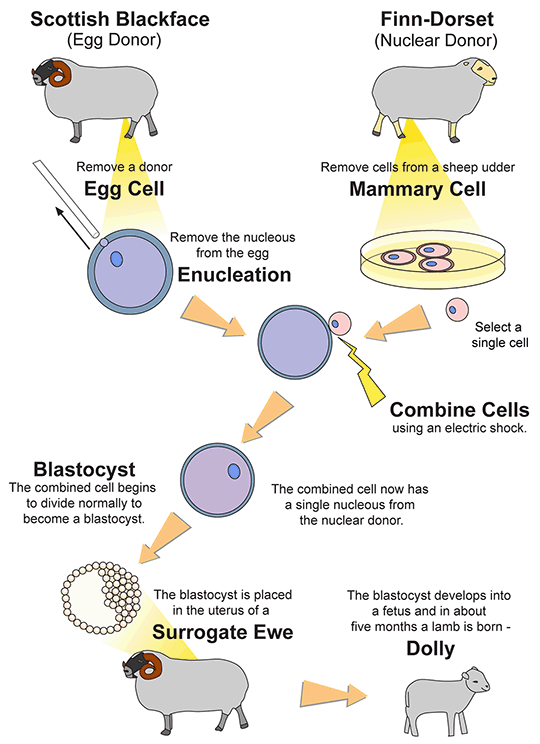The Story of Dolly

Dolly is the name of a sheep that has the honor of being the first mammal to be cloned by a group of scientists in Scotland. Dolly was born July 5th, 1996 and she passed away in 2003. She lived for 6 and a half years, as a normal, active ewe. She was not that normal though, she was a clone after all.
There are several breeds of sheep in the world. The sheep we focus on here are easy to remember though. One breed of sheep is the Scottish Blackface and the other is a Finn Dorset. What is easy about those names is that the Blackface actually has a black face. The Finn Dorset is all white. You know that the genetic material in our cells determines how we look on the outside. The black face of the Blackface sheep is determined by its genetic material, which means you can check to see who has that genetic material by just looking at their face! Very easy!
How Dolly Was Made

In Dolly's case, the nucleus of an egg from a black faced sheep was removed. The nucleus from a white faced sheep was inserted into that egg. Now, they had just one cell with the nucleus of a white faced sheep, but the rest of the cell containing items from a black faced sheep. That cell was placed into the black faced sheep who's egg it started out as. The cell eventually grew up and made Dolly. When Dolly was born, her face was white!

Black faced sheep never have white faced sheep. Dolly's face being white was good proof that the experiment was successful, but scientists double checked Dolly's genetic material. They found that Dolly did have the exact same genetic material as the white faced sheep that donated the nucleus. Dolly did not have any genetic material from the black faced sheep who was her mother.
The story was first published as a short report in a scientific journal called Nature, Volume 385, 1997, pages 810-812. Since that time, attempts at cloning at least 10 species of mammals have been made. Only seven attempts have been successful; cows, sheep, goats, mice, pigs, cats, and rabbits. The rate of success is very low.
Several questions are brought up by Dolly's life and death. Scientists were interested to see if she aged faster because the genetic material was older than that from a fertilized egg. It was thought that she was aging faster, but no one could be sure. Dolly's cells looked a little older in a region in the genetic material, but is that enough to cause premature aging? Dolly got arthritis, a disease that mainly affects older individuals, but again, no one could be sure if it was because she was a clone. Some animals get arthritis early in life. Dolly even gave birth to a daughter, who was completely normal in all ways. Dolly led an active, healthy, sheep life until she passed away.
Dolly got severely sick with a lung infection that affects many sheep. Scientists decided to put her down, euthanize her, to end her suffering. Dolly passed away when she was six and a half years old. That is half the average lifespan for a Finn Dorset sheep. She is now stuffed and on display in Edinborough, Scotland. We learned a lot from Dolly while she was alive and when she had passed away, but she might have left many more questions than answers.
Image of Iam Wilmut feeding his cloned sheep Dolly from http://dnabiob.wikispaces.com/Ian+Wilmut accessed June 5, 2012.
Read more about: Cloning Ewe
Bibliographic details:
- Article: The Story of Dolly
- Author(s): Dr. Biology
- Publisher: Arizona State University School of Life Sciences Ask A Biologist
- Site name: ASU - Ask A Biologist
- Date published:
- Date accessed:
- Link: https://askabiologist.asu.edu/content/story-dolly
APA Style
Dr. Biology. (). The Story of Dolly. ASU - Ask A Biologist. Retrieved from https://askabiologist.asu.edu/content/story-dolly
Chicago Manual of Style
Dr. Biology. "The Story of Dolly". ASU - Ask A Biologist. . https://askabiologist.asu.edu/content/story-dolly
Dr. Biology. "The Story of Dolly". ASU - Ask A Biologist. . ASU - Ask A Biologist, Web. https://askabiologist.asu.edu/content/story-dolly
MLA 2017 Style

Dolly the sheep on display at the National Museum of Scotland. Image by Toni Barros via Wikimedia Commons.
Be Part of
Ask A Biologist
By volunteering, or simply sending us feedback on the site. Scientists, teachers, writers, illustrators, and translators are all important to the program. If you are interested in helping with the website we have a Volunteers page to get the process started.


